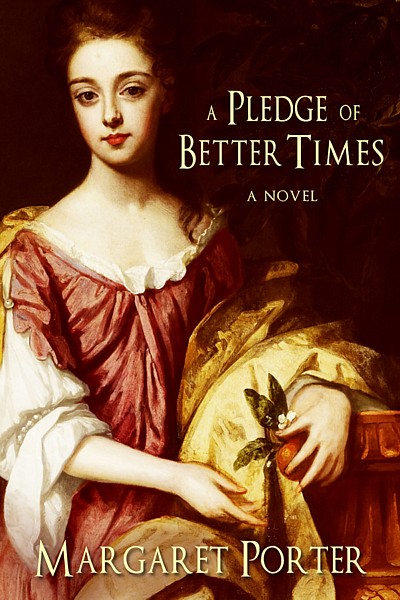Publication Date: April 14, 2015
Gallica Press
Formats: eBook, Paperback
ISBN: 978-0-9907420-4-3
Pages: 400
Genre: Historical Fiction
A sweeping tale of ambition, treachery, and passion...
 For generations Lady Diana de Vere’s family loyally served England’s crown. But after King Charles II’s untimely death, her father firmly opposes James II’s tyranny. Charles Beauclerk, Duke of St. Albans—the late king’s bastard son by actress Nell Gwyn—also rebels against his newly crowned uncle's manipulation. Secretly pledging to wed Diana, he departs for the Continent to become a soldier.
For generations Lady Diana de Vere’s family loyally served England’s crown. But after King Charles II’s untimely death, her father firmly opposes James II’s tyranny. Charles Beauclerk, Duke of St. Albans—the late king’s bastard son by actress Nell Gwyn—also rebels against his newly crowned uncle's manipulation. Secretly pledging to wed Diana, he departs for the Continent to become a soldier.Political and religious turmoil bring about revolution and yet another coronation before Charles returns to claim his promised bride. As companion to Queen Mary II, Diana has followed her de Vere forbears into royal service. She expects Charles to abandon his military career after marriage, but he proves unwilling to join the ranks of the courtiers he despises and mistrusts.
In palace corridors and within their own household the young duke and duchess confront betrayals, scandals, and tragedies that threaten to divide them. And neither the privileges of birth nor proximity to the throne can ensure their security, their advancement—or their happiness.
Guest Post
A Pledge of Better
Times
contains a diverse array of women, prominent and not, who lived and loved
during the final decades of the 17th century and the opening years
of the 18th century.
The
primary female character is Lady Diana de Vere, daughter of the 20th
Earl of Oxford. An obscure figure, her education and upbringing are a mystery. She
would have learned what was necessary for young ladies destined for court life:
needlework, dancing, singing, playing an instrument, French language. Her
eventual marriage to the First Duke of St. Albans, illegitimate son of King
Charles II and actress Nell Gwyn, made her the mistress of a grand house near
Windsor Castle and the various London residences they occupied. Later in life
she rose to become Mistress of the Stole and First Lady of the Bedchamber to
the Princess of Wales, and presumably in real life she demonstrated the skills essential
to carry out these prestigious appointments.
The real
Diana and my fictional Diana are more both virtuous than her mother. Diana “Di”
Kirke was She was very much a court lady of the Restoration era—her morals, or
lack of them, reflect that. Bred at court, Di was notoriously naughty, sleeping
with several court gentlemen before becoming Lord Oxford’s mistress. Her
pregnancy resulted in their marriage, and after bearing him several children
she had other affairs. Perhaps Di served as a cautionary example to her
daughter Diana, who came of age during Mary II’s reign and was probably
influenced by the devout and virtuous queen she served. But Di, as well as
Diana’s maidservant Catty, also serve as models of strength and independence.
The two
Queens depicted, sisters Mary and Anne, were brought up together as Protestant
princesses. Their education consisted of church teachings, music, dancing, and
fashionable foreign languages. Prone to enthusiastic affections—what today we
call “crushes”—they wrote effusive letters to their friends, aping the language
of male-female courtship. And though
they were heiresses presumptive to their uncle King Charles II, neither was
tutored in state craft before or after their own father ascended the throne as
James II.
Charles arranged
Mary’s marriage to her first cousin, Prince William of Orange, and she wept for
days after learning of her engagement. After her bridegroom took her to
Holland, her misery abated. She not only fell in love with her husband, she appreciated
the simpler Dutch style of living. Her contentment was ruptured by William’s
invasion of England in what became known as the Glorious Revolution, which toppled
her Catholic father from the throne. Although Mary’s claim to the crown was
higher, monarchical power was vested in William. Parliament preferred having a
king, even if he was a Dutchman, and Mary believed that to outrank him—and rule
over him—would be contrary to the laws of God. A reluctant Queen, she felt burdened
by the responsibilities of governing whenever William waged war on the
Continent against his great enemy Louis XIV. But however much she disliked
ruling in his stead, she demonstrated good sense and a skill for handling her
very troublesome councilors and advisors.
Unlike her
friend Mary, my fictional Diana revels in being in control, and she is quick to
exert herself in opposition to her husband when she disagrees with him. Her
challenges strengthen her, and she is a survivor. Although I depict her as a
woman of her time, in some respects she is the one the modern reader will
probably identify with the most.
Another
strong female in the novel is Sarah Churchill, who rose from lowly court maiden
to the most powerful woman in England after Queen Anne. She caused many a
quarrel between the royal sisters Mary and Anne and was responsible for the complete
breakdown in their relationship. My portrait of Sarah is unflattering, but
perhaps not as much as the ones drawn by her own contemporaries! Her vigorous
personality and her influence over Anne served her well for most of her life,
but as her own worst enemy she had only herself to blame for her ultimate
downfall.
My
research for A Pledge of Better Times offered more enlightenment about women
of the time—royals, aristocrats, servants—than I could possibly fit into a
novel. But within the period covered by the novel, the seeds of change were
just beginning to sprout—although it would be decades, even centuries, before
they bore fruit!
Praise for A Pledge of Better Times
“Meticulously researched and offering an impressive cast of real life characters brought to vibrant life, A Pledge of Better Times expertly captures the drama, passions, politics and religious turmoil of England at the turn of the 18th century. Margaret Porter crafts her story with exquisite detail, transporting the reader into a world full of intrigue, scandal, and breathtaking danger . . . a masterful writer.” - Award-winning author M. Reed McCall“With elegant prose and vivid detail, A Pledge of Better Times sweeps you into late Stuart England, transforming the lesser known adversities and triumphs of Lady Diana de Vere and Charles Beauclerk into a beautiful love story you won’t forget.” - Marci Jefferson, author of Enchantress of Paris and Girl on the Golden Coin
“A portrait of Diana de Vere as rich as the portraits that grace British museums and palaces.” - Christy K Robinson, author of Mary Dyer Illuminated
“The sparkling, dangerous, enticing post-Restoration period comes to vivid life! Porter gives us a wonderful, complicated heroine in Diana, drawing us deep into her world . . . . I couldn’t stop reading!” - Amanda Carmack, author of Murder in the Queen’s Garden: An Elizabethan Mystery
Official Book Trailer
About the Author
 Margaret Porter is an award-winning, bestselling novelist whose lifelong study of British history inspires her fiction and her travels. A former stage actress, she has also worked in film, television, and radio.
Margaret Porter is an award-winning, bestselling novelist whose lifelong study of British history inspires her fiction and her travels. A former stage actress, she has also worked in film, television, and radio.For more information please visit Margaret Porter's website. You can also find her on Facebook here and here, and on Twitter.
A Pledge of Better Times Blog Tour Schedule
Monday, May 4Review at Just One More Chapter
Review & Giveaway at Broken Teepee
Spotlight & Giveaway at Mina's Bookshelf
Tuesday, May 5
Review at 100 Pages a Day - Stephanie's Book Reviews
Wednesday, May 6
Guest Post & Giveaway at Let Them Read Books
Thursday, May 7
Review at Book Drunkard
Friday, May 8
Review at Books and Benches
Sunday, May 10
Review & Guest Post at With Her Nose Stuck in a Book
Monday, May 11
Review at Reading the Past
Tuesday, May 12
Review at Flashlight Commentary
Wednesday, May 13
Guest Post at Book Babe
Thursday, May 14
Review at Unshelfish
Review at Impressions in Ink
Review at Caroline Wilson Writes
Friday, May 15
Review & Giveaway at A Literary Vacation
Review & Giveaway at Historical Fiction Obsession


No comments:
Post a Comment